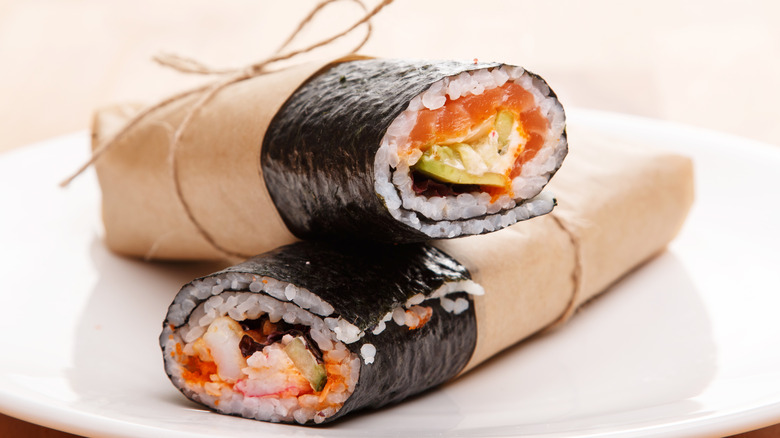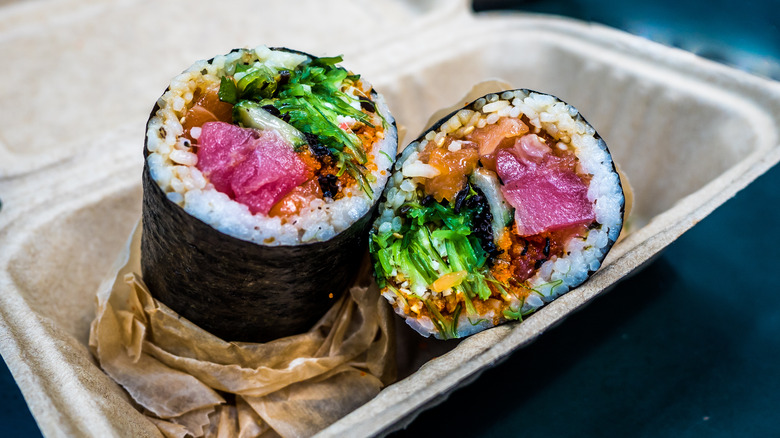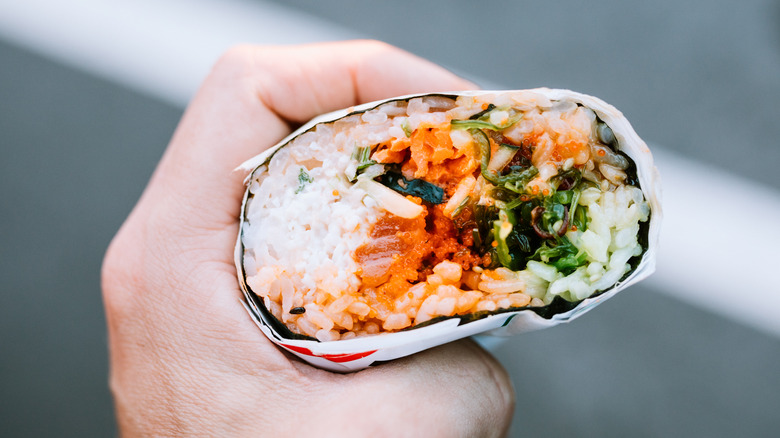The Best Fillings For Homemade Sushi Burritos
Sushi and burritos may at first appear to occupy very different places in your dining routine. Sushi is simple and decadent, fit for date night or a special splurge. Meanwhile, a burrito is your Girl Friday — filling and dependable, great for a casual lunch on the go or a post-party carbo load.
But, what if you could have the best of both? Enter: The Sushi Burrito. She's comfort food with a luxurious twist and she's super easy to make. Essentially, a sushi burrito is sushi made in the form of a burrito so that it's easy to eat and a bit less fussy. It's not entirely dissimilar from temaki, a larger sushi-like Japanese hand roll, but this one is closer to the look of a burrito.
The great thing about a homemade sushi burrito is that you can basically fill it up with whatever you feel like. Start with sushi rice and some nori (dried seaweed) and throw in whatever leftovers you have on hand, from lox to chopped carrots.
Sushi burrito fillings
While a lot of ingredients typically used in sushi (namely sushi-grade raw fish) are on the pricier side, you would be surprised how many pantry staples can be incorporated into a sushi burrito in their place. The sushi burrito is an excellent vehicle for many kinds of tinned or cured fish, such as some ready-to-eat tinned salmon from Trader Joe's, a little leftover tuna salad, or even lox.
If you don't do meat, that's no problem! Mushrooms like enoki or shiitake can add a meaty textural dimension. You can even use dried shiitakes, rehydrate them in water, and then use the now-flavored water to cook your sushi rice for some extra umami.
A little bit of roe (fish eggs), or the seaweed pearls that often serve as their vegan alternative, can add a nice pop of brininess to your sushi burrito. Any loose vegetables, like carrots, cabbage, or cucumbers, can be julienned and added to your sushi burrito for a bit of freshness and crunch. (Pickled vegetables or kimchi would also not be an unwelcome addition ... bonus points if it's pickled ginger like the kind they serve alongside your sushi in a restaurant.) Seaweed salad or sea beans are also great for texture and salinity.
Assembling your sushi burrito
Make sure you have short grain rice on hand before you start prepping your sushi burrito — It makes all the difference. Adding a little sugar and vinegar after cooking will give it that perfect sushi rice flavor. You'll also need nori, or large sheets of dried, pliable seaweed, which can be purchased at most Asian grocery stores. Two sheets of this lightly glued together around the edges with water should make a hefty enough base for your sushi burrito.
Top your nori with a layer of rice, then slice up a ripe avocado alongside your vegetables, and lay them flat along the sushi rice. Top with your chopped fish or a few scoops of tuna or salmon mixed with mayo. Sprinkle with furikake and bonito flakes if you have them, or a drizzle of soy sauce spiked with wasabi.
If you want to make your sushi burrito in advance without the nori getting soggy, simply mix your rice, protein, and veggie ingredients together, roll them into a log, then store the log in the fridge in parchment paper. (The sticky rice will help the log maintain its shape.) When you're ready to eat, take it out and simply roll it up in your nori sheets. (More perishable items like avocado may not be as suited to advanced preparation.)



